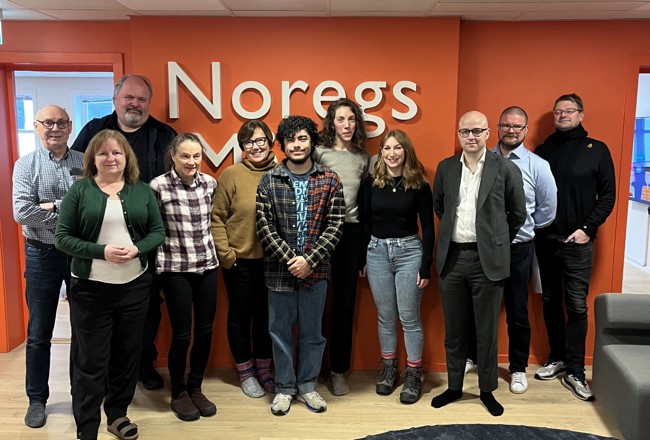- Share icon
- Share on LinkedIn
- Share on Twitter
- Share on Facebook

Dr Manon Wynn Davies, the Welsh Language Commissioner's Research and Place-names Officer visited Norway recently to deliver a presentation about the Welsh language to a youth organisation that promotes Nynorsk. Here are her reflections following the visit.
At the beginning of January I accepted an invitation to go to Norway to give a presentation on the situation of the Welsh language to Norsk Målungdom, a youth organisation that promotes Nynorsk, the minority written form of Norwegian. Bokmål is the form mostly used, while around 15% of Norwegians, mainly in the west, use Nynorsk. The organisation holds a weekend camp every winter for its members and this year the camp was held on 24–26 January in Dovre, about four hours by train from Oslo. The weekend was free to all attendees and my presentation was part of a full programme over the weekend which included talks and presentations from guest speakers along with fun activities. They were very interested to hear about the status of the Welsh language in Wales and to better understand what the Welsh Language Commissioner and other organisations are doing to promote the Welsh language. They were also keen to hear about people's attitudes towards Welsh, comparing our situation here in Wales and that of Nynorsk there.
Norway, like us, have a language act that provides for the preservation of the Norwegian language, the promotion of equality between Nynorsk and Bokmål and ensures that public institutions are responsible for the development and strengthening of both forms. The act also protects minority languages in Norway such as the Sami languages. In Norway, local authorities are expected to declare whether they use Nynorsk, Bokmål or if are they neutral.
After a long trip back to Oslo, I met with two other organisations interested in hearing more about the Commissioner's work and the Welsh language: Noregs Mållag, the main Norwegian language organisation that promotes Nynorsk, and Språkrådet, the organisation that advises the government on linguistic matters and regulates public institutions' compliance with the language act. I learned that Språkrådet is also responsible for standardising terminology, for language technology developments and for standardising place-names. With my day-to-day work in the Commissioner's office concerned with the standardisation of place-names, it was very amusing to hear about the Norwegian place-names act created in 1990. The act stipulates that the standard forms of place-names must be used for official purposes, and that the standard forms must be based on local and traditional pronunciation adhering to orthographic rules. In the areas where Nynorsk is strongest, the Nynorsk spelling may be the recommended standard form and the form expected to be seen on signs, for example.
The history of the two written forms, Nynorsk and Bokmål, is quite unique, and the best comparison I could think of was to think of the dialect and vocabulary differences between north and south Wales. We might have been in a similar situation if Welsh orthography hadn't been standardised at a national level, people from north Wales could be writing in the way that we speak and people from south Wales could be writing in their own slightly different way. It's the same language, but there would be differences in the spelling and in some of the words. Or maybe that's over-simplifying things...
After Norway became independent from Denmark and distanced itself from Danish as a language in 1814, a man named Ivar Aasen travelled the length and breadth of Norway collecting the dialects of the rural areas and creating a standard orthography in light of his research. It is believed that the dialect of these rural areas was closer to the original Norwegian language, unlike the dialect of the cities which still had strong Danish influence. He set about publishing grammar books and a dictionary in the mid-19th century and used his own orthography to write and publish stories, poems and essays. The orthography that Ivar Aasen created is what has developed into Nynorsk today.
The impression I got at the camp in Dovre was that Ivar Aasen had turned into something of a legend. There was a cardboard cut-out of him at the door welcoming me into the room and the young people there would start singing songs he had written at every opportunity between the more formal presentations and talks. And what a great thing it was to see these young people so passionate for the cause of their language, but also celebrating it and enjoying it at the same time, which I think is so important for us in Wales to do too. Formalising the use of a minority language is crucial to giving it status and credibility, but laughing and having fun in Welsh, and in Nynorsk, is just as important. As one of our own poets, Mei Mac, once said: ' yn Gymraeg mae’i morio hi, yn Gymraeg y mae rhegi’ (Welsh is the way to sing, Welsh is the way to swear)!
